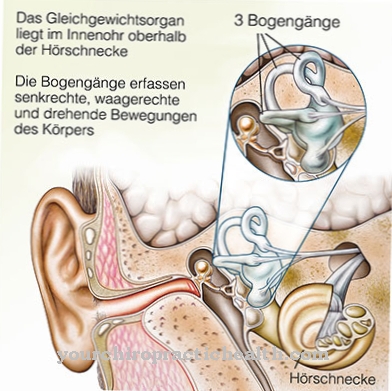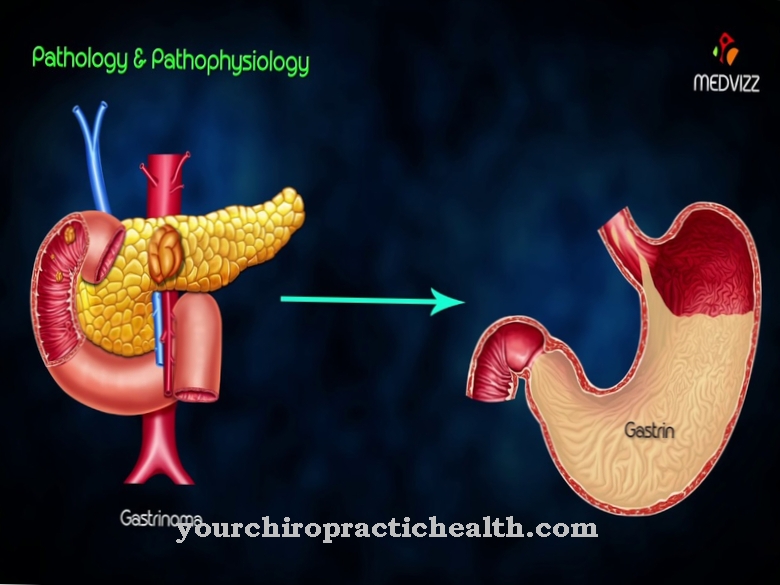A pandemic is the spread of a disease over a very large area. The real flu (influenza) occurs as a pandemic approximately every 25 to 30 years. Vaccinations, clean drinking water and physical hygiene are among the most important tools for preventing pandemics.
What is a pandemic?

© Delphotostock - stock.adobe.com
Medicine speaks of one pandemicwhen a disease spreads nationwide. Usually several countries and even several continents are affected. This means that the pandemic is more widespread than the epidemic, in which an illness is limited to a smaller region. Accordingly, both pandemic and epidemic do not relate to a specific clinical picture, but to the degree of spread of diseases.
Any infectious disease can theoretically become a pandemic. Infections that are highly contagious - for example real flu or influenza - are particularly affected. Every 25 to 30 years, a variant of the viral disease spreads as a pandemic, while in the remaining years it generally occurs as an epidemic.
Medicine, but also popular science publications, also use the term pandemic to describe other phenomena. In recent years, for example, there has been increasing talk of an obesity pandemic.Morbid obesity is not caused by a contagious disease, but it is so widespread around the world that it meets the criteria of a pandemic.
causes
The exact causes of a pandemic depend on which disease is spreading as a pandemic. In the case of an infectious disease that can be traced back to a virus, the mutation of the causative agent is often a decisive factor in the outbreak of a pandemic. The human immune system is not adjusted to the mutated virus and cannot defend itself sufficiently against the intruder.
However, not every mutation has to lead to a pandemic. Another factor are unfavorable living conditions - for example after wars or major natural disasters. These situations are often associated with a lack of safe drinking water and poor general hygiene, which encourages the spread of infectious diseases. In addition, medical care is made more difficult in such crisis areas.
Travel and trade routes are usually significantly involved in the spread of the pandemic. Due to global networking, a virus can easily migrate from one continent to another - for example on board an airplane. However, pandemics existed long before these options were available.
Symptoms, ailments & signs
Symptoms can vary depending on the underlying disease. Influenza typically manifests as a fever with aching limbs, chills, cough, and inflammation of the airways. Patients often feel exhausted and dull. Headache, chest pain and eye pain can also occur.
Slow pulse and low blood pressure are also possible. However, a pandemic does not have to manifest itself in clear symptoms like the real flu. AIDS, which is caused by the HI virus, is also considered a pandemic. In this case, however, several years can pass after the infection before the disease becomes noticeable through more pronounced symptoms.
In the acute phase of the HI infection, however, the disease manifests itself in many people similar to influenza a few weeks after infection: with fever, feeling sick, tiredness, headache, muscle and / or joint pain, loss of appetite and weight, rash, hyperhidrosis (Night sweats) and other symptoms.
Diagnosis & course of disease
In many cases, virus and bacterial infections can be detected with the help of suitable tests so that doctors can assign the pandemic to a clear cause. In order to record and illustrate the extent of a pandemic, medical professionals still use maps today on which the number of people affected is entered for different areas.
This method was developed by the Englishman John Snow, who was able to identify a well as the cause of a local cholera epidemic. The course of the disease is specific to the particular infection. After the First World War, around 22 million people died of the so-called Spanish flu between 1918 and 1920. That is more victims than the world war itself claimed. The WHO estimates the number of people who have died as a result of HIV infection since the 1980s at 39 million.
Complications
In most cases, a pandemic will not have particular complications if the flu is treated well. Complications usually only arise if hygiene is not observed or if the pandemic is not treated. Patients with this disease suffer from the common ailments and symptoms of the flu.
The main result is a high fever and fatigue. Without treatment, people also suffer from pneumonia and usually feel tired and exhausted. The patient's quality of life will be significantly reduced by the pandemic. The pandemic can also cause pain in the chest or eyes.
Furthermore, there are rashes on the skin and loss of appetite. The pandemic can of course only be treated if appropriate medication is available. The complaints can thus be limited. However, if the diagnosis or treatment is late, the patient's life expectancy drops significantly. In many cases this unfortunately leads to the death of the person concerned.
When should you go to the doctor?
A pandemic is a disease that spreads quickly across national borders. Infectious diseases often spread very rapidly because there is an increased risk of infection. If a pandemic has already broken out in your own immediate region, a visit to the doctor must not be delayed. In a personal consultation, it can be discussed which measures can be taken with regard to prevention or treatment. If you do not visit the doctor, there is an acute risk of infection. These types of infectious diseases cause typical symptoms such as fever, headache and body aches.
Medical treatment and medication must be given at the latest when these symptoms appear. With the help of appropriate medication, a significant improvement can be brought about within a very short time. However, if the sick person refrains from such treatment, the symptoms will worsen very quickly. The following therefore applies: If the first signs that could be associated with a pandemic can be seen, a doctor should be consulted as soon as possible. Complications and complaints can be ended with a visit to the doctor.
Treatment & Therapy
In the event of a pandemic, the treatment of the individual affected depends on the respective illness. In addition, if a pandemic is identified, emergency plans come into force in many countries that have already been established for this purpose. One possible measure is to limit travel to areas where the pandemic has already spread.
Travelers and other people who may have already been infected may also be quarantined after their return in order to monitor their state of health and discover symptoms in good time. After the incubation period has expired, those concerned can usually leave the quarantine. In the case of infectious diseases like Ebola, people in the immediate vicinity are particularly at risk.
In order to identify new pandemics and epidemics as early as possible, certain diseases must be reported. A doctor who diagnoses the infection must report the disease to the competent authority. Such a reporting obligation (without a name) exists in Germany, for example, syphilis.
Outlook & forecast
The prognosis of a pandemic depends to a considerable extent on the general state of health of the person concerned. Life-threatening health developments can occur in high-risk patients. They include children, the elderly and people who already have previous illnesses. In those affected, the immune system is not yet mature or weakened. The pathogens can therefore spread faster in these people and lead to a sharp increase in symptoms. In unfavorable conditions and without the fastest possible medical care, the patient can die quickly and prematurely.
At the beginning of a pandemic, historical developments show that there is an increased death rate over a long period of time. Several million patients often die from the new disease that has broken out. In this phase, researchers and doctors must first identify the pathogen in order to be able to prevent it from spreading.
People who basically have a stable immune system and a healthy lifestyle usually have a more favorable prognosis when a pandemic breaks out. As soon as they seek medical treatment, medication is often used to stabilize their health. If researchers can quickly develop an agent that will contain the pandemic, recovery is possible.
prevention
In addition to the early detection of pandemics, preventive measures help protect the population. Vaccinations represent effective prevention against many viral diseases, including influenza. When it comes to the flu virus, an important goal is to reduce the chance of dangerous mutations and to protect those who can also die from a simple flu infection. In addition to rapid medical care, hygienic standards such as clean drinking water and basic personal hygiene also help to prevent pandemics.
Aftercare
In the event of a pandemic, no specific and direct follow-up measures can usually be predicted, as the treatment of the disease is very dependent on its type and severity. Therefore, the person affected should consult a doctor as soon as the first signs and symptoms of the respective disease appear, so that it cannot spread and thus further complications and complaints can be prevented.
In most cases, it cannot heal independently, so treatment by a doctor is always necessary. A pandemic can usually be prevented with various vaccinations. These can still be done after a successful treatment so that the infection does not recur.
Contact with other people should be avoided as much as possible while the disease is being treated. It is also important to ensure a high standard of hygiene, whereby above all only purified drinking water should be drunk. In general, the body itself should be well protected to prevent infection. Whether the disease will reduce the life expectancy of the person affected cannot generally be predicted.
You can do that yourself
Since the term pandemic describes the spread of a human disease across countries and continents, important behaviors are often decisive in reducing the further transmission of the disease considerably.
In the event of a worldwide outbreak of a disease, in the narrower sense of an infectious disease, important protective measures must be taken by each individual. Sick people should definitely stay at home to rule out any further risk of infection and people who have not yet been infected should avoid crowds and physical contact with sick people. When dealing with sick people, it is in the personal interest to avoid touching your own eyes, nose and mouth.
In order to minimize the risk of infection, hands should also be avoided or the use of other everyday objects such as cell phones should be avoided. Thorough hand washing and hand disinfection is a preventive measure. It is also advisable to wear a mouth and nose protection when dealing with the sick. Thorough, regular disinfection and cleaning of door handles, sanitary facilities, cutlery, etc. is recommended. Contaminated handkerchiefs, disposable gloves or breathing masks are to be disposed of in separate garbage bags, well closed, with household waste.
These rules of hygiene and behavior, as well as the usual household disinfection recommendations, are mere preventive measures and rules of conduct in the event of a pandemic. They serve as a precautionary measure and to minimize damage. The pandemic planning is an important emergency plan and informs the population step by step via the media, hotlines and the internet about what to do in an emergency.

.jpg)

.jpg)























